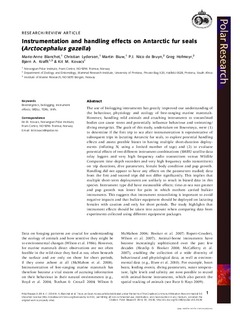| dc.contributor.author | Blanchet, Marie Ann | |
| dc.contributor.author | Lydersen, Christian | |
| dc.contributor.author | Biuw, Erik Martin | |
| dc.contributor.author | Bruin, N | |
| dc.contributor.author | Hofmeyr, Greg | |
| dc.contributor.author | Krafft, Bjørn Arne | |
| dc.contributor.author | Kovacs, Kit M. | |
| dc.date.accessioned | 2014-09-16T08:23:10Z | |
| dc.date.accessioned | 2015-05-04T08:22:47Z | |
| dc.date.available | 2014-09-16T08:23:10Z | |
| dc.date.available | 2015-05-04T08:22:47Z | |
| dc.date.issued | 2014-02-21 | |
| dc.identifier.citation | Polar Research 2014, 33, 21630, http://dx.doi.org/10.3402/polar.v33.21630 | nb_NO |
| dc.identifier.issn | 0800-0395 | |
| dc.identifier.issn | 1751-8369 | |
| dc.identifier.uri | http://hdl.handle.net/11250/282956 | |
| dc.description.abstract | The use of biologging instruments has greatly improved our understanding of the behaviour, physiology and ecology of free-ranging marine mammals. However, handling wild animals and attaching instruments to streamlined bodies can cause stress and potentially influence behaviour and swimming/diving energetics. The goals of this study, undertaken on Bouvetøya, were (1) to determine if the first trip to sea after instrumentation is representative of subsequent trips in lactating Antarctic fur seals, to explore potential handling effects and assess possible biases in having multiple short-duration deployments (inflating N, using a limited number of tags) and (2) to evaluate potential effects of two different instrument combinations (SMRU satellite data relay loggers and very high frequency radio transmitters versus Wildlife Computers time–depth recorders and very high frequency radio transmitters) on trip durations, dive parameters, female body condition and pup growth. Handling did not appear to have any effects on the parameters studied; data from the first and second trips did not differ significantly. This implies that multiple short-term deployments are unlikely to result in biased data in this species. Instrument type did have measurable effects; time-at-sea was greater and pup growth was lower for pairs in which mothers carried bulkier instruments. This suggests that instrument streamlining is important to avoid negative impacts and that bulkier equipment should be deployed on lactating females with caution and only for short periods. The study highlights that instrument effects should be taken into account when comparing data from experiments collected using different equipment packages. | nb_NO |
| dc.language.iso | eng | nb_NO |
| dc.publisher | Co-Action publishing | nb_NO |
| dc.title | Instrumentation and handling effects on Antarctic fur seals (Arctocephalus gazella) | nb_NO |
| dc.type | Journal article | nb_NO |
| dc.type | Peer reviewed | nb_NO |
| dc.date.updated | 2014-09-16T08:23:11Z | |
| dc.subject.nsi | VDP::Mathematics and natural science: 400::Zoology and botany: 480::Marine biology: 497 | nb_NO |
| dc.source.pagenumber | 10 p. | nb_NO |
| dc.source.volume | 33 | nb_NO |
| dc.source.journal | Polar Research | nb_NO |
| dc.identifier.doi | 10.3402/polar.v33.21630 | |
| dc.identifier.cristin | 1154812 | |
